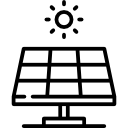
ANU is one of the largest energy users in the ACT. Our campus has research and teaching spaces and energy-intensive facilities supporting our community in producing world-leading research and learning activities, such as the National Computational Infrastructure, which houses one of Australia's most powerful supercomputers. ANU is also home to thousands of students and visitors who live, study, and work on campus. Our buildings and infrastructure are essential for our continued impact and engagement with our community and region.
The primary goal of the energy management pillar in our Environmental Management Plan 2022-2025 is to optimise the energy efficiency of our built environment, controls and processes. These goals include increasing the University's capacity to generate renewable energy on campuses. Read more about our renewable energy projects below.
Installation and upkeep of renewable energy systems
In 2020, a major hailstorm damaged 90 per cent of the rooftop solar photovoltaic (PV) systems on the ANU campus. Over the next four years, the hail remediation project repaired or replaced these affected PV systems. These repair works also presented an opportunity to install additional PV capacity on campus. Aligning the installation of new systems with the ongoing construction meant less disruption for the occupants and safer conditions for contractors as the buildings were already scaffolded. ANU added four new PV systems and increased capacity of one existing system in 2023 and 2024:
- John Curtin School of Medical Research (JCSMR) (2023)
- Science Teaching Building (2023)
- Michael Birt Wing (2023)
- Linnaeus Building (2024)
- National Computational Infrastructure (NCI) (2024)
The following installations further increased solar electric (PV) capacity on the Acton and Stromlo ANU campus.
- The Australian Plant Phenomics Facility (APPF) replaced hail-damaged PV systems on two of four outdoor growth environments (ANU Below Zero funded, 2023).
- On Mt Stromlo, the ANU Observatory had a new PV system installed (2023).
Repair and upkeep of operational and non-operational systems continue. New renewable energy generation projects continue to be considered, with expected long-term growth of the University's capacity.
Energy generation - the numbers
Installed capacity of PV systems before the 2020 hailstorm
In 2020, ANU had solar PV systems with an installed capacity of approximately 535 kW (predominately on the Acton campus). This capacity refers to the total power output of the installed solar panels under Standard Test Conditions. After the 2020 hail storm, these systems stopped generating solar electricity as they were no longer operational or turned off for safety reasons. All systems will have been repaired by the end of 2024.
Installed capacity of PV systems on buildings
The buildings with newly installed or increased-capacity systems in 2023-2024 have energy-intensive research infrastructure that requires a high electricity base load. This base load typically exceeds the solar electricity generation from the PV system, which is limited by the available roof space. In these cases, the buildings use all renewable electricity the PV system generates, and nothing is exported beyond its boundaries. The four new systems increased the total rooftop PV installed capacity by approximately 415 kW. On NCI, the system's capacity increased from 95 to 160 kW.
Installed capacity on additional systems
- APPF container growth capsules (installed in 2023) have a capacity of 10 kW.
- Mount Stromlo PV system (installed in 2023) has a capacity of 100 kW.
By the end of 2024, the total PV system capacity installed on ANU campus is anticipated to reach approximately 1.125 MW.
Monitoring and evaluation of renewable energy systems
Solar electricity meters were installed on these systems to monitor renewable energy generation. Metering allows the ANU to include the cumulative data of total renewable energy generated in its annual reporting.
ANU is also building an Energy Dashboard. This dashboard aims to visualise the University's resource use across several utilities, including electricity, gas and water. The meters on these rooftop PV systems can integrate the renewable energy generation data in real time so staff can monitor these systems continuously and visualise solar energy generation over time.
Enabling success - supporting future projects
To contribute to the success of future rooftop solar installations, the ANU team that manages these projects added a section to the Campus Building Requirement Manual section for PV systems to support all future projects. This manual is published online so other organisations can incorporate what we have learned into their planning.



